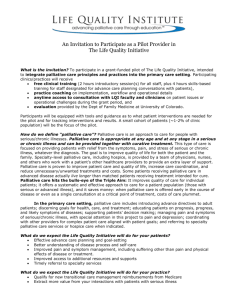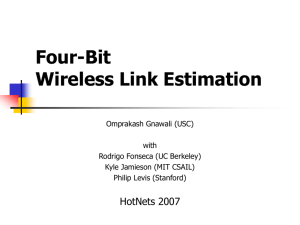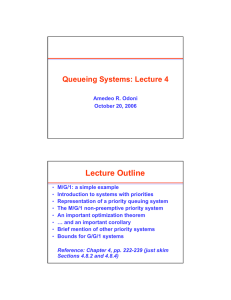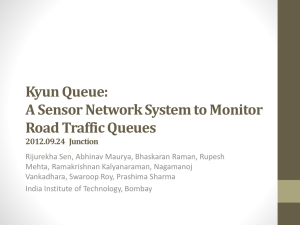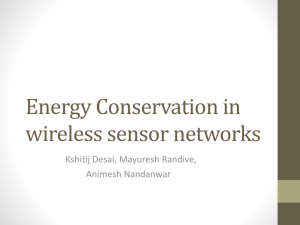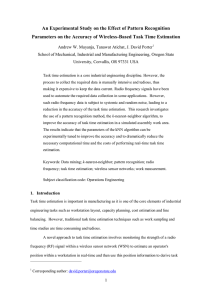Experimental Study: A LQI-Based Ranging Technique in ZigBee Sensor Networks
advertisement
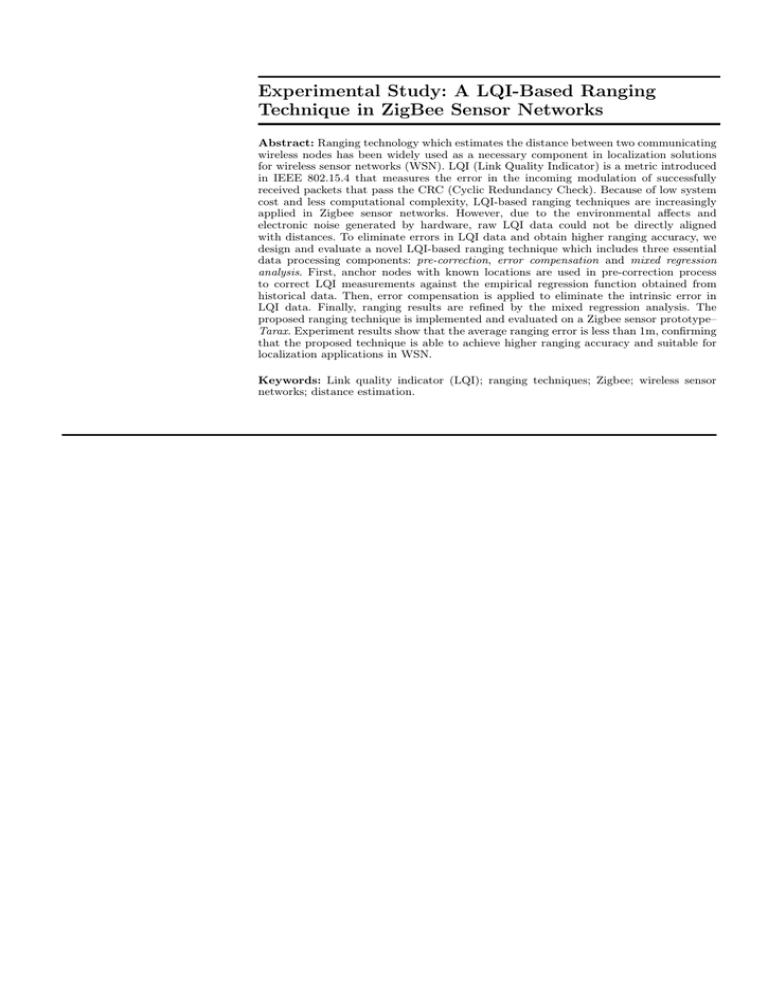
Experimental Study: A LQI-Based Ranging
Technique in ZigBee Sensor Networks
Abstract: Ranging technology which estimates the distance between two communicating
wireless nodes has been widely used as a necessary component in localization solutions
for wireless sensor networks (WSN). LQI (Link Quality Indicator) is a metric introduced
in IEEE 802.15.4 that measures the error in the incoming modulation of successfully
received packets that pass the CRC (Cyclic Redundancy Check). Because of low system
cost and less computational complexity, LQI-based ranging techniques are increasingly
applied in Zigbee sensor networks. However, due to the environmental affects and
electronic noise generated by hardware, raw LQI data could not be directly aligned
with distances. To eliminate errors in LQI data and obtain higher ranging accuracy, we
design and evaluate a novel LQI-based ranging technique which includes three essential
data processing components: pre-correction, error compensation and mixed regression
analysis. First, anchor nodes with known locations are used in pre-correction process
to correct LQI measurements against the empirical regression function obtained from
historical data. Then, error compensation is applied to eliminate the intrinsic error in
LQI data. Finally, ranging results are refined by the mixed regression analysis. The
proposed ranging technique is implemented and evaluated on a Zigbee sensor prototype–
Tarax. Experiment results show that the average ranging error is less than 1m, confirming
that the proposed technique is able to achieve higher ranging accuracy and suitable for
localization applications in WSN.
Keywords: Link quality indicator (LQI); ranging techniques; Zigbee; wireless sensor
networks; distance estimation.
2
XX et al.
1 Introduction
Wireless sensor network (WSN) consists of spatially
distributed autonomous sensors and are often randomly
deployed in a large area for environmental monitoring,
target tracking and security surveillance. In these
applications, it is necessary to accurately orient the
nodes with respect to a global coordinate system in
order to report data that is geographically meaningful.
Therefore, localization in WSN has been an active area
for decades.
To achieve localization in WSN, some algorithms
rely on pre-positioned nodes while others may require
expensive specially-designed hardware. Some algorithms
need a way of performing off-line computation, while
others can do all calculations on sensors in real time.
Localization is still an challenging and exciting field,
with new algorithms, hardware, and applications being
developed at a feverish pace. Generally, there are
two major localization techniques in the literature:
range-based and range-free algorithms (1). Since range
measurements between nodes usually contain errors,
a node’s location can only be estimated. Localization
algorithms dependent on distance measurements are
sensitive to ranging errors. Range-free algorithms can
overcome this problem, however, they perform poorly
in irregular networks (2). This paper aims at improving
ranging accuracy by desiging a novel LQI-based ranging
technique for practical localization applications.
In this work, we closely investigated the relationship
between LQI data and the distances being measured.
From experiment results, we discovered that LQI data
could be affected by other wireless networks, e.g.
the WiFi networks (nearby the test sites) can cause
interference to Zigbee networks. In addition, we found
that LQI data are intensively correlated to distances
when the distances are less than 3 meters, i.e. within this
range, LQI gradually decreases when distance increases.
Based on the above-mentioned observations, we first
introduce a pre-correction algorithm to reduce the errors
in LQI data by including reference nodes. Combing with
the error compensation and mixed regression analysis,
an new ranging method is established so that the error in
distance estimation is minimized to an acceptable level.
2 Related Work
There are numbers of ranging techniques in wireless
sensr networks including time of arrival (TOA), received
signal strength indication (RSSI), time difference of
arrival (TDOA), angle of arrival (AOA), etc. Some
of these technologies may need special hardware, e.g.
TDOA uses ultrasonic devices (3), AOA (4) requires
antenna arrays. TOF does not need additional hardware
and can calculate the distance between a sensor and
an anchor node based on round-trip time (RTT) of
packets. However, to obtain a higher ranging accuracy,
lots of computing resources are needed to process huge
amount of RTT samples (5; 6). Moreover, due to
the low signal-to-noise ratio(SNR), multi-path fading
and hardware noise, huge errors are expected in RTT
measurements (7).
2.1 Received Signal Strength Indication (RSSI)
RSSI has been widely used in wireless link quality
assessments, distance measurements, and localization
algorithms. An early system called RADAR (8) uses
RSSI fingerprints to estimate a node’s location. In (9),
an approximated ranging technique by eliminating the
mean error in RSSI was presented.
There are several works trying to enhance ranging
accuracy based on RSSI data, e.g. Gauss model is used
in (10), and (11) proposed a recursive filtering algorithm
using weighted average with smooth factor map RSSI
signal. Split range technique (12) is used to estimate
approximate distance and able to predict the path of a
moving target. There are other studies on CC2420 (13),
which use standard deviation of RSSI and packet loss to
estimate distance.
Previous studies have shown that reflection,
scattering and other physical properties have severe
impacts on RSSI measurements (14). Although (15)
introduced an adequately adjusted RSSI measurements,
the instability of RSSI measurement is always a
problem. There are also approaches using artificial
neural network (16) and RSSI fingerprint (17) to address
the issues of environmental impact on RSSI.
2.2 Link Quality Indicator (LQI)
Recently, a new type of metric measuring wireless link
was provided on Zigbee devices. The new metric is called
Link Quality Indicator (LQI) which could be used for
distance estimation (18).
LQI is a metric used to estimate the link qualities
of RF transmissions. As defined in IEEE802.15.4, LQI
is calculated by the physical layer and provides signal
strength and link quality information to network and
above layers after every data frame is received. LQI is
relevant to the successful reception of data frames, i.e.
higher LQI indicates better link quality and lower data
loss rate.
For example, in the MC13224v chipset developed by
Freescale, the value of LQI is an integeral multiple of 3,
ranging from 0x00 to 0xFF where 0x00 corresponds to 100dBm and 0xFF corresponds to -15dBm. The formula
of computing LQI in MC13224v is as follows:
LQI(dec)
− 100)
3
In the API provided by MC13224v, the function
MLMELinkQuality() can be used to return a pointer
referring to a 8-bit LQI value.
LQI has a wider range than RSSI, so it has a better
resolution. When wireless devices are close to each other,
LQI(dBm) = (
c 2008 Inderscience Enterprises Ltd.
Copyright ⃝
Experimental Study: A LQI-Based Ranging Technique in ZigBee Sensor Networks
3
the LQI data have less deviation and mean-square (19).
In (20), an experimental study was performed by using
both RSSI and LQI in estimating distance between
sensors. The results in (20) indicate that when LQI
increases, the probability of correctly estimating distance
is increasing. In (21), RSSI/LQI with fuzzy logic and
TBM classification methods are used. The authors
claimed that they can receive 80% ranging accuracy
when devices are less than 4-meter between each other,
but errors spread beyond 4 meters.
Figure 1
Illustration of Atmosphere Impact on LQI
3 Towards LQI-Based Ranging
To completely understand whether and how LQI can
be used in ranging techniques, we first designed
and developed a wireless Zigbee sensor prototype–
Tarax. Creating a new prototype is necessary because
commercial off-the-shelf (COTS) Zigbee devices may
not meet our specific needs. In addition, COTS devices
may not support user customization, which makes
system debugging almost impossible. The Tarax node
has a master chip MC13224v developed by Freescale,
which contains a 2.4GHz RF transceiver, a 32-bit
ARM7 processor, and an IEEE 802.15.4-compliant MAC
protocol. Antenna is also an important component in
getting consistent LQI readings. In experiments, only
one type of antenna is used, i.e. a single-ended 50 Ohm
antenna with 0dBi antenna gain. In all experiments, we
use two Tarax WSN nodes: one as the receiver and the
other as the transmitter. Both of them are placed at the
same height (0.5m from the ground). We fix the receiver’s
location and move the transmitter away from the receiver
with a step size of 0.5m. There is no obstacle between
these two nodes.
was conducted during a weekday starting from 11:00AM
to 11:00AM the next day. The figure shows that LQI
data somehow correlated to human activities. In other
words, LQI data fluctuate from 11:00AM to 10:00PM,
but become stable from 10:00PM to 9:00AM. Because
there is no human intrusion during tests, one possible
explanation of LQI fluctuation is co-channel interference
with WiFi signals. Due to the unpredictable nature of
data traffic from other intefering networks, randomness
in LQI data are expected to be seen.
3.3 Correlation between LQI and Distance
To investigate whether LQI data are correlated to
distances, we conduct experiments in an open concrete
field. The distances between transmitter and receiver
nodes increase from 0m to 40m with a step size of 1m.
At each distance, 100 LQI data are collected, and the
average of these data is plotted in Figure3.
3.1 Environmental Impacts on LQI
To fully understand the environmental impacts on LQI
of this particular type of Tarax node, we conduct several
tests in different environments including a open field
(concrete), a soil ground, a grass land, and an indoor
environment.
As shown in Figure 1, we collected a set of LQI data
at different atmospheric pressures (957Pa, 956Pa and
963Pa) when Tarax nodes are placed on a concrete open
field. The figure shows that atmospheric pressures has no
notable affect on LQI data. We also conduct experiments
in different humidity and temperature, and no significant
affect on LQI are observed. When environmental setting
is fixed, similar LQI data are observed. However, the
LQI data from different environment are quite different,
indicating environmental impact on LQI could not be
ignored.
3.2 Inteference from Other Wireless Network
Figure 2 shows a 24-hr continuous measurements of
LQI data in an indoor environment. The experiment
Figure 3
Correlation Between LQI and Distance within
40 Meters
As shown in Figure 3, although LQI data decline
as distances increase, the plotted curve is not smooth,
indicating a weak correlation between LQI data and
distances. When distances are less than 10m, LQI data
decrease faster with fewer fluctuations. However, more
oscillations are observed when distances is greater than
10m. Overall, when distances increase, more LQI errors
occur and the correlation between LQI and distances
become more complicated. Therefore, The proposed
ranging technique in this paper only works when devices
are close to each other (i.e. within 10 meters).
4
XX et al.
Figure 2
Illustration of the Impact of Human Activities on LQI
3.4 Intrinsic Errors in LQI
In Figure 3, we also notice that LQI data slightly
increase when the distance changes from 4m to 5m. To
further understand this issue, we conduct several other
experiments with different experiment setup parameters
in various environments, and results from all scenarios
show the same phenomenon. Thus, we conjecture that
data fluctuation occurring from 4 to 5 meters may be
caused by intrinsic errors in the hardware MC13224v.
Although data fluctuation are observed in Figure 3,
generally, LQI data decrease when distances increase,
which is true for all experiments we conducted. After
analyzing all experiment results, we discover that
fluctuations in different experiments follow a similar
pattern. This important observation implicitly reveal
that LQI data could be used for distance estimation
given the intrinsic errors being identified and eliminated.
4 LQI-Based Ranging Technique
To realize a practical ranging technique, the LQIbased ranging algorithm must overcome the following
challenges: 1) it must be resilient to the change of
experimental environments; 2) it must be able to detect
and eliminated the intrinsic errors in LQI data; and 3)
due to unpredictable channel interference, randomness
of LQI data is expected, and hence it must be resilient
against the variation of LQI. We propose a novel
ranging technique to meet these challenges via three
key algorithms: pre-correction, error compensation, and
mixed regression analysis.
4.1 Empirical Regression Function
Because LQI data are affected by many factors, an
effective way to identify the relationship between LQI
and distance is to conduct regression analysis on huge
amount of data. By analyzing LQI data, an empirical
regression function can be built to reflect the correlation
between LQI data and distances. As shown in Figure 4,
an logarithmic and polynomial fitting functions are
shown based on the LQI data collected from our
experiments.
Figure 4
Illustration of the Empirical Regression
Functions
In Figure 4, the logarithmic and polynomial functions
have R2 < 0.9, which means both of them are very close
to the real LQI-and-distance curve. Since the polynomial
function gives better results, we choose polynomial
regression function to estimate the distances between
nodes.
4.2 Pre-Correction Algorithm
As we discussed in Section 3.1, although atmospheric
pressure (as well as humidity and temperature) do not
have notable impact on LQI data, differences in the
regression functions of various environments still exist.
As shown in Figure 5, we conduct two experiments at the
same location on different days, and the curves of ”day1”
and ”day2” are the regression functions corresponding
to the data collected in these two days, respectively. The
other curve is the empirical regression function obtained
by analyzing large amount of historical data. At the same
distance, LQI data from different experiments (”day1”
and ”day2”) show differences from the empirical curve.
However, the trends of regression functions are similar,
which means it is possible to build an accurate regression
function by pre-correcting LQI data.
To eliminate minor differences between the actual
and empirical regression functions, we make use of
anchor nodes (with known locations). The basic idea of
the pre-correction algorithm is to find the differences
Experimental Study: A LQI-Based Ranging Technique in ZigBee Sensor Networks
Figure 5
show large deviations, unified correction may not be
applicable as correction would result in even greater
errors. Under this circumstance, {δi } data should be
grouped, and the number of groups is determined by the
distribution of δi .
As shown in Figure 7, {δi } are divided into three
groups, and {δi } in each group has a small deviation.
Within each group, unified correction is used to correct
the LQI data {LQI(i)}. The correction value of LQI in
each group is calculated as follows:
LQI Differences Between the Actual and
Empirical Regression Functions
∑km
between the empirical regression function and the one
corresponding to the current experiment data. When
new LQI data are collected, they will be adjusted
based on these differences to closely match the empirical
regression function. There are two ways to eliminate the
differences: 1) using the average differences of LQI to
perform a unified correction, and 2) using the differences
of similar LQI to conduct a grouped correction. We will
first describe how to obtain LQI differences and then the
error elimination approaches.
As shown in Figure 6, anchor nodes are denoted as
A0 , A1 , . . . , Ak , the distances from A0 to A1 , A2 , . . . , Ak
are d1 , d2 , . . . , dk , the target node is M whose location
needs to be estimated. The LQI data and corresponding
distances can be grouped into tuples as < LQI10 , d1 >
, < LQI20 , d2 > . . . , < LQIk0 , dk >. Since the reference
node A0 can be any nodes in {A1 , A2 , . . . , Ak }, we
use a general form < LQI1 , d1 >, < LQI2 , d2 > . . . , <
LQIk , dk > to denote the LQI data measured by a anchor
node with other k − 1 anchor nodes. Comparing LQIi
to the LQI value from the empirical regression function
at the distance di , differences δi between them can be
computed. Let’s use LQI(i) to denote the LQI measured
by the target node M from node Ai .
A1(LQI1,d1)
A2(LQI2,d2)
A0
LQI(1)
Ak(LQIk,dk)
LQI(2)
LQI(0)
LQI(k)
A3(LQI3,d3)
Figure 6
M
LQI(3)
Illustration of the Pre-Correction Process
If the values of δi are similar, we use the average of
δi to correct the LQI data {LQI(i)}. The average LQI
difference is computed as follows:
∑k
δ=
i=1 δi
k
, |δi − δj | ≤ ϵ, i, j ∈ {1, . . . , k}
5
(1)
where ϵ is an adjustable parameter that can be
configured according to application requirements. If {δi }
δm =
i=1 δi
km
, |δi − δj | ≤ ϵm , i, j ∈ {1, . . . , km }
(2)
where m is the index of each group, δ m is the correction
value of LQI in group m, km is the number of {δi } in
group m, ϵm is the maximum difference of δi in group
that can be determined by the applications.
Figure 7
Example of the Group Correction Process
Figure 7 shows the grouped δi collected in the
experiment ”day2”. In the figure, there are three
different groups of δi , the δ m of each group is shown as
a dash line.
Due to the fluctuation of LQI, similar LQI may
correspond to different distances. Besides, LQI(i) may
not have a corresponding tuple (with same distance)
in {δi }. To address these issues, the grouped correction
works as follows.
Step1 We first define an LQI interval ∆, e.g. 10dBm.
Then, LQIi in < LQIi , di > can be grouped into a set B
as follows. Starting from the min{δi }, group all LQIi less
than (min{δi } + ∆) into a subset B0 . Update {LQIi }
to {LQIi } − {B0 }, and find the next group in the same
way. Then the average LQI correction value δ m of each
group m can be computed accordingly.
Step2 If LQI(i) appears in a certain group Bm , then
goes to Step3 ; otherwise, switch to Step4.
Step3 If LQI(i) exist in only one group Bm , then δ m
can be used to correct LQI(i) to LQI(i) + δ m . If LQI(i)
n
appears in two groups, e.g. Bm and Bn , then δm +δ
will
2
be used to correct LQI(i).
Step4 If LQI(i) does not appear in any group Bm ,
then the LQIj : min{|LQIj − LQI(i)|} is chosen and
goes to Step3. If there are more than one LQIj existing
in more than one group, then the average δ m of these
group will be used to correct LQI(i).
According to extensive experiment results, the precorrection algorithm can effectively reduce ranging errors
6
XX et al.
caused by environmental factors. At the initial stage
of localization, there may be only few anchor nodes
available in the networks, pre-correction algorithm will
not work well. However, as more nodes being localized,
more anchor nodes can be identified and the precorrection algorithm will become more beneficial.
Overall, the pre-correction process first calculates the
LQI difference {δi } between measured LQIs and those
from the empirical regression function. Then, either
unified or grouped correction is used to correct the
measured LQIi so that the errors between measured and
historical LQI are minimized.
4.3 Error Compensation
Although the pre-correction algorithm eliminates
environmental impact on LQI data, intrinsic errors may
exist in LQI data due to several other factors including
unknown software defects, hardware noise, issues in
communication protocols, etc. In this section, we first
analyze the intrinsic errors existing in LQI data and
then discuss an approach to deduct these errors.
Figure 8 shows the intrinsic error curve of the
regression function we used. Similar curve exist in LQI
data from all experiments, so we believe the errors are
caused by hardware and/or software, and always appear
in LQI data. Coupling with regression function shown in
Figure 4, the intrinsic errors increase when the LQI data
decline quickly, e.g. around 4m and 8m. Therefore, the
first step is to deduct intrinsic errors from measured LQI
data. The idea of compensating intrinsic errors is similar
to the grouped correction strategy.
Second, from Figure 4 and other results, we note
that LQI data decrease monotonically within 3.5m,
i.e. the LQI data uniquely corresponds to a distance
(within 3.5m). Besides, the LQI data beyond 3.5m are
all less than those within 3.5m. Therefore, if LQI(i) >
LQI[3.5m] where LQI[3.5m] is the average LQI at 3.5m,
then the LQI data can be use to directly estimate a
distance; otherwise, it should correspond to a distance
greater than 3.5m.
Third, if compensated LQI data corresponds to a
distance which is out of the communication range, then
the data before compensation will be used.
4.4 Mixed Regression Analysis
The pre-correction and error compensation approaches
try to eliminate errors between measurement LQI curve
and the empirical regression function. However, the
empirical regression function may contains some errors
which is modeled as R2 . to address this issue, a mixed
regression analysis strategy is used to further improve
the ranging accuracy. We consider four classical fitting
curves: polynomial, linear, exponential and logarithmic
curves. Figure 9 shows the ranging errors in different
fitting curves. From 9 and several other experiments, we
draw the following three conclusions.
Figure 9
Figure 8
Illustration of Intrinsic Errors in the Empirical
Regression Function
Since the empirical regression function is obtained
from huge amount of historical LQI data, it is a known
curve before every ranging test. However, due to the
randomness in LQI data, there may be some unexpected
errors in LQI which can not be handled by either
the pro-correction or the error compensation processes.
Therefore, the error compensation scheme can only be
applied in certain conditions.
First, if compensated LQI data is not reasonable,
then the LQI data before compensation is used. For
instance, if the distance computed from a smaller
LQI (after error compensation) is shorter than that
calculated from a larger LQI, then the ranging result is
questionable and should be ignored.
Average Ranging Errors of Different Fitting
Curves
First, all fitting curves (polynomial, linear,
exponential and logarithmic) give increasing ranging
errors when distances becomes larger. All curves show
similar errors at the same distance except for those at
7.5m, 9m and 10m.
Second, within 5m, polynomial curve give the
smallest ranging error.
Third, beyond 5m, polynomial curve give the best
ranging results except for the distance at 7.5m.
After analyzing the errors in four different fitting
curves, we perform a mixed regression analysis in
our ranging algorithm. When LQI(i) > LQI[3.5m],
the transmitter and receiver are close to each other,
and the distance between them can be calculated
from polynomial regression function. When LQI(i) <
LQI[3.5m], we first compute the LQI differences δ of the
four different fitting curves. Then, applying the majority
rule to eliminate the fitting curve(s) that has large errors.
For example, at distance 7.5m, polynomial regression
function will be eliminated. If the majority rule does not
Experimental Study: A LQI-Based Ranging Technique in ZigBee Sensor Networks
7
applied, e.g. at distance 10m, then we use polynomial
function as a default function.
5 Experiments and Data Analyses
To evaluate the accuracy of the proposed ranging
techniques including pre-correction, error compensation
and mixed regression analysis, we conduct another set
of experiments. Experiments are conducted at both the
public square of the University of Electronic Science
and Technology of China (UESTC) and in the UESTC’s
main building.
Before the ranging tests, we first collect LQI data
from 10 randomly-chosen distances. Since these LQI data
are obtained from nodes with know locations, they are
used in the pre-correction process. Then, we place the
transmitter and receiver close to each other (distance is
0m) and move the transmitter away from the receiver
with the step size of 0.5m. For every distance, we collect
20 LQI data and use the average LQI as the measured
LQI at this distance. Overall, we have the first set of
data for pre-correction and the second for ranging tests.
With the help of the first set of data, group correction is
applied to pre-correct the second set of data. As shown
in Figure 10, the pre-corrected LQI curve matches the
the regression function curve perfectly.
Figure 10 Comparison of Pre-Corrected and Regression
Function Curves
To illustrate the necessities of all proposed
techniques, we process the second set of data in four
different ways. The first one uses raw LQI data and the
empirical regression function to compute distances. The
second one utilizes pre-correction algorithm to correct
measured LQI and then substitute into the regression
function to compute distance. The third one additionally
apply the error compensation strategy. The last one
process the data with all proposed techniques. As shown
in Figure 11, the maximum ranging error of the first
method is around 6.5m, while the errors of the last one
is less than 0.9m. Statics summary of results from the
last one is shown in Table 1.
To compare with other LQI-based ranging techniques
in literature, we replicated the algorithms proposed
Figure 11
Table 1
Comparison of Multiple Strategies
Statistic Summary of Ranging Errors of
Proposed Technique
Err.< 1m
100%
Err.< 0.5m
90%
Avg.
0.25m
Max.
0.80m
Min.
0.01m
in (22) and (23). Table 2 summarizes the the average
ranging errors for different methods. Although (23)
provides a similar average ranging error as the proposed
technique, it works badly when the distance is larger
than 5 meters. From this table, we conclude the proposed
ranging technique has better ranging accuracy.
6 Conclusion
From extensive experimental studies, we are positive
that LQI data could be used to estimate the distances
between sensors. The calculated distances from LQI data
are close to the true values, except for some rare cases
where LQI fluctuate severely. The overall performance of
the proposed ranging technique is acceptable, i.e. with
an average ranging error less than 1m.
After analyzing LQI data from many experiments,
we discover there are huge errors in raw LQI data i.e.
randomness in LQI necessitate the proposed processing
techniques: pre-correction, error compensation and
mixed regression analysis. Verified by experiment data,
the above-mentioned techniques can effectively eliminate
the errors in LQI data and significantly improve the
ranging accuracy.
Although data fluctuations exist, LQI is an important
metric in estimating distances because of the lost
cost, low energy consumption and low requirements
of hardware. Although the accuracy of the proposed
LQI-based ranging techniques can be affected by
physical environments, hardware and software, its
performance meets the requirements of most WSN
ranging/localization applications.
References
[1] Hui Liu, H. Darabi, P. Banerjee, and Jing Liu.
Survey of wireless indoor positioning techniques and
systems. Systems, Man, and Cybernetics, Part C:
Applications and Reviews, IEEE Transactions on,
37(6):1067–1080, 2007.
8
Table 2
XX et al.
Average Errors of Different LQI-Based Ranging Techniques
Ranging Techniques
Proposed algorithm
Ref (22)
Dynamic Ranging
Ref (23)
Average Error
0.25m
1.23m
0.86m
0.71m
0.24m
[2] Bram Dil, Stefan Dulman, and Paul Havinga.
Range-based localization in mobile sensor networks.
Wireless Sensor Networks, 3868:164–179, 2006.
[3] Nissanka B. Priyantha, Anit Chakraborty, and Hari
Balakrishnan. The cricket location-support system.
In Proceedings of the 6th annual international
conference on Mobile computing and networking,
MobiCom ’00, pages 32–43, 2000.
[4] D. Niculescu and B. Nath. Ad hoc positioning
system (APS) using AOA. In INFOCOM 2003.
Twenty-Second Annual Joint Conference of the
IEEE Computer and Communications, volume 3,
pages 1734–1743, 2003.
[5] Yubin Zhao, Yuan Yang, and M. Kyas. Comparing
centralized kalman filter schemes for indoor
positioning in wireless sensor network. In Indoor
Positioning and Indoor Navigation (IPIN), 2011
International Conference on, pages 1–10, Sept.
Metric(s)
LQI only
RSSI only
LQI only
LQI and RSSI
LQI only
Environment/Range
Outdoor/10m
Outdoor/10m
Indoor/8m
[11] Zheng Zhang, Guocheng Wan, Min Jiang, and
Guangyou Yang. Research of an adjacent correction
positioning algorithm based on rssi-distance
measurement. In Fuzzy Systems and Knowledge
Discovery (FSKD), 2011 Eighth International
Conference on, volume 4, pages 2319–2323, 2011.
[12] V. Daiya, J. Ebenezer, S.A.V.S. Murty, and
Baldev Raj. Experimental analysis of rssi for
distance and position estimation.
In Recent
Trends in Information Technology (ICRTIT), 2011
International Conference on, pages 1093–1098,
2011.
[13] A. Faheem, R. Virrankoski, and M. Elmusrati.
Improving rssi based distance estimation for
802.15.4 wireless sensor networks. In Wireless
Information Technology and Systems (ICWITS),
2010 IEEE International Conference on, pages 1–4,
2010.
[6] Qing Yang Ting Yang and A. Lim. Driver layer
approach to time-of-arrival ranging in IEEE 802.11g
networks.
In Consumer Communications and
Networking Conference (CCNC), 2012 IEEE, pages
240–244, Jan.2012.
[14] K. Benkic, M. Malajner, P. Planinsic, and Z. Cucej.
Using rssi value for distance estimation in wireless
sensor networks based on zigbee. In Systems,
Signals and Image Processing, 2008. IWSSIP 2008.
15th International Conference on, pages 303–306,
2008.
[7] Hui Liu, H. Darabi, P. Banerjee, and Jing Liu.
Survey of wireless indoor positioning techniques and
systems. Systems, Man, and Cybernetics, Part C:
Applications and Reviews, IEEE Transactions on,
37(6):1067–1080, Nov.
[15] G. Gracioli, A.A. Frohlich, R. P. Pires, and
L. Wanner. Evaluation of an rssi-based location
algorithm for wireless sensor networks.
Latin
America Transactions, IEEE (Revista IEEE
America Latina), 9(1):830–835, 2011.
[8] P. Bahl and V.N. Padmanabhan. RADAR: an
in-building RF-based user location and tracking
system. In INFOCOM 2000. Nineteenth Annual
Joint Conference of the IEEE Computer and
Communications Societies. Proceedings. IEEE,
volume 2, pages 775–784 vol.2, 2000.
[16] A. Awad, T. Frunzke, and F. Dressler. Adaptive
distance estimation and localization in wsn
using rssi measures. In Digital System Design
Architectures, Methods and Tools, 2007. DSD 2007.
10th Euromicro Conference on, pages 471–478,
2007.
[9] P. Kumar, L. Reddy, and S. Varma. Distance
measurement and error estimation scheme for RSSI
based localization in wireless sensor networks. In
Network Protocols and algorithms, 2009 Fifth IEEE
Conference on, pages 1–4, 2009.
[17] S. Gansemer, U. Grossmann, and S. Hakobyan.
Rssi-based euclidean distance algorithm for indoor
positioning adapted for the use in dynamically
changing wlan environments and multi-level
buildings.
In Indoor Positioning and Indoor
Navigation (IPIN), 2010 International Conference
on, pages 1–6, 2010.
[10] Zhang Jianwu and Zhang Lu. Research on distance
measurement based on rssi of zigbee. In Computing,
Communication, Control, and Management, 2009.
CCCM 2009. ISECS International Colloquium on,
volume 3, pages 210–212, 2009.
[18] Monique Becker, Andre-Luc Beylot, Riadh Dhaou,
Ashish Gupta, Rahim Kacimi, and Michel Marot.
Experimental study: Link quality and deployment
Experimental Study: A LQI-Based Ranging Technique in ZigBee Sensor Networks
issues in wireless sensor networks. In Proceedings
of the 8th International IFIP-TC 6 Networking
Conference, NETWORKING ’09, pages 14–25.
Springer-Verlag, 2009.
[19] Q. Hu, Q. Zeng, F. Zhao, and Y. Liang. Research
on LQI location algorithm and errors for wireless
sensor networks. Journal of Chinese Computer
Systems, 32(1):95–98, 2011.
[20] M. Raju, T. Oliveira, and D.P. Agrawal.
A
practical distance estimator through distributed
RSSI/LQI processing - an experimental study. In
Communications (ICC), 2012 IEEE International
Conference on, pages 6575–6579, 2012.
[21] T. Oliveira and D.P. Raju, M.and Agrawal.
Accurate distance estimation using fuzzy based
combined RSSI/LQI values in an indoor scenario:
Experimental verification. Special Issue on and
smart Communication Protocols and Algorithms on
Network Protocols and algorithms, 4(4):174–199,
2012.
[22] Wang Xia Zhang Jieying, Sun Maohang. Dynamic
distance estimation method based on rssi and lqi.
Electronic Measurement Technology, 30(2):142–145,
2007.
[23] Chu Hongyan Zhu Qianjie. Experimental analysis of
nodes distance measurement based on lqi. Journal
of Nanjing Normal University(Engineering and
Technology Edition, 10(3):40–43, 2010.
9
